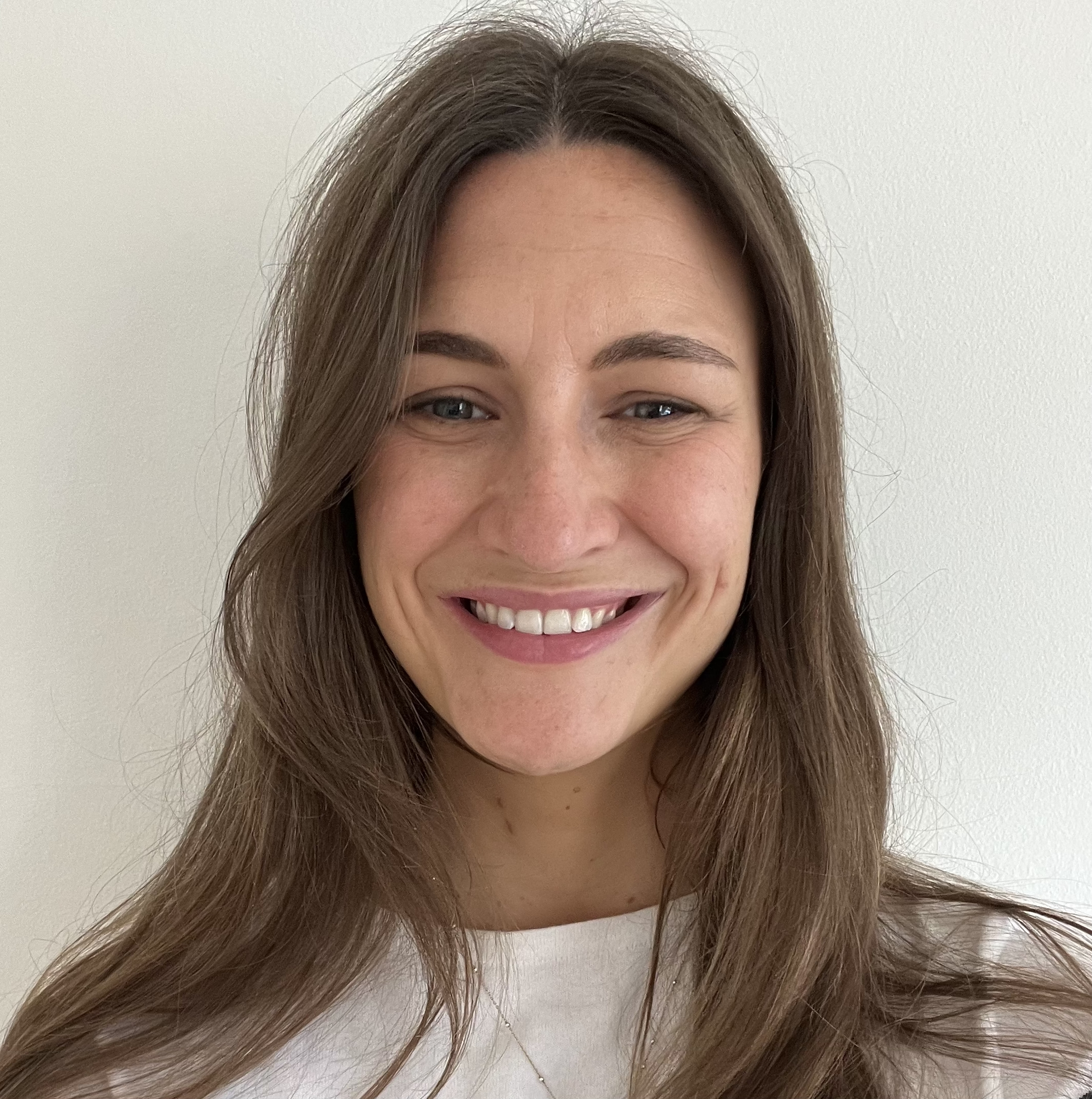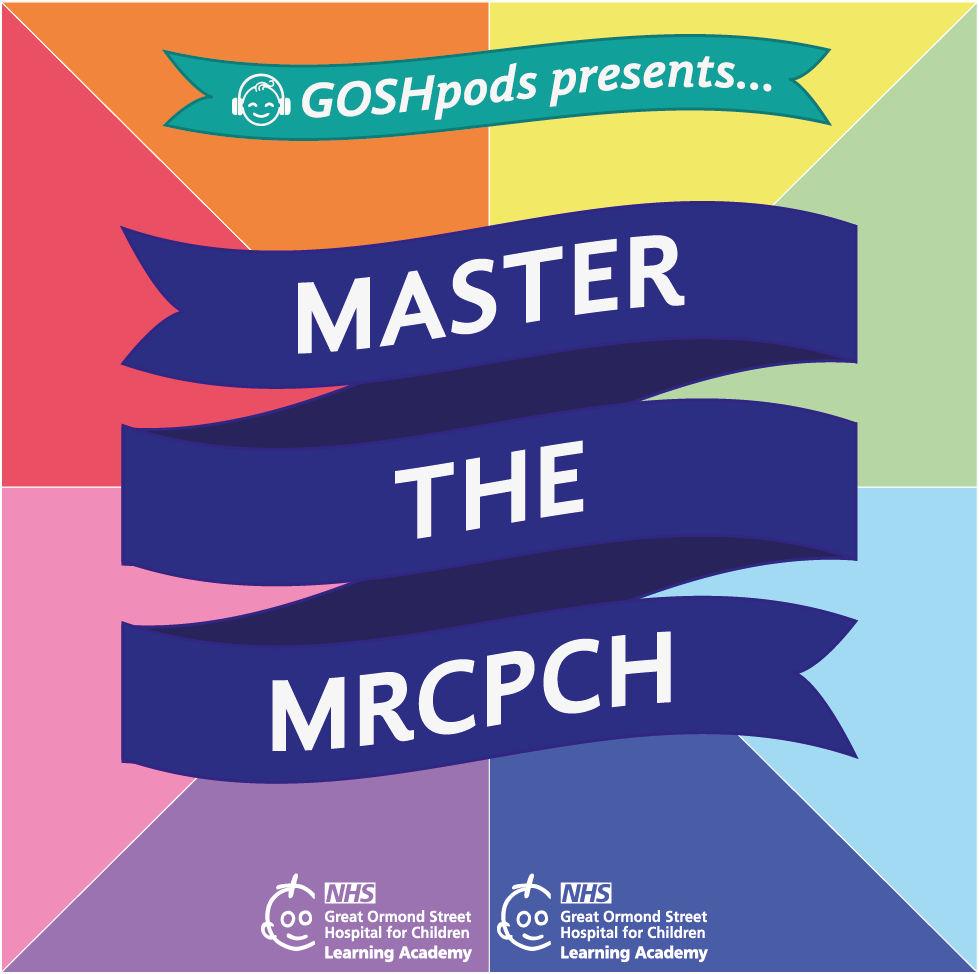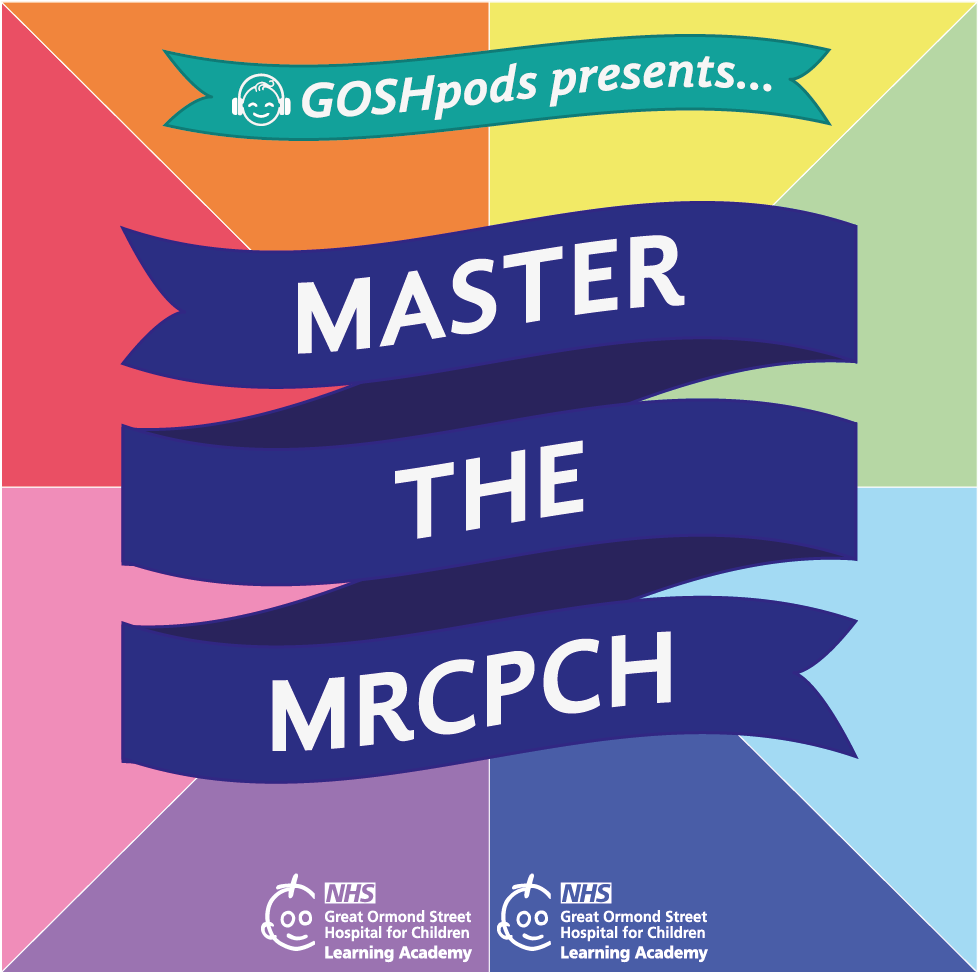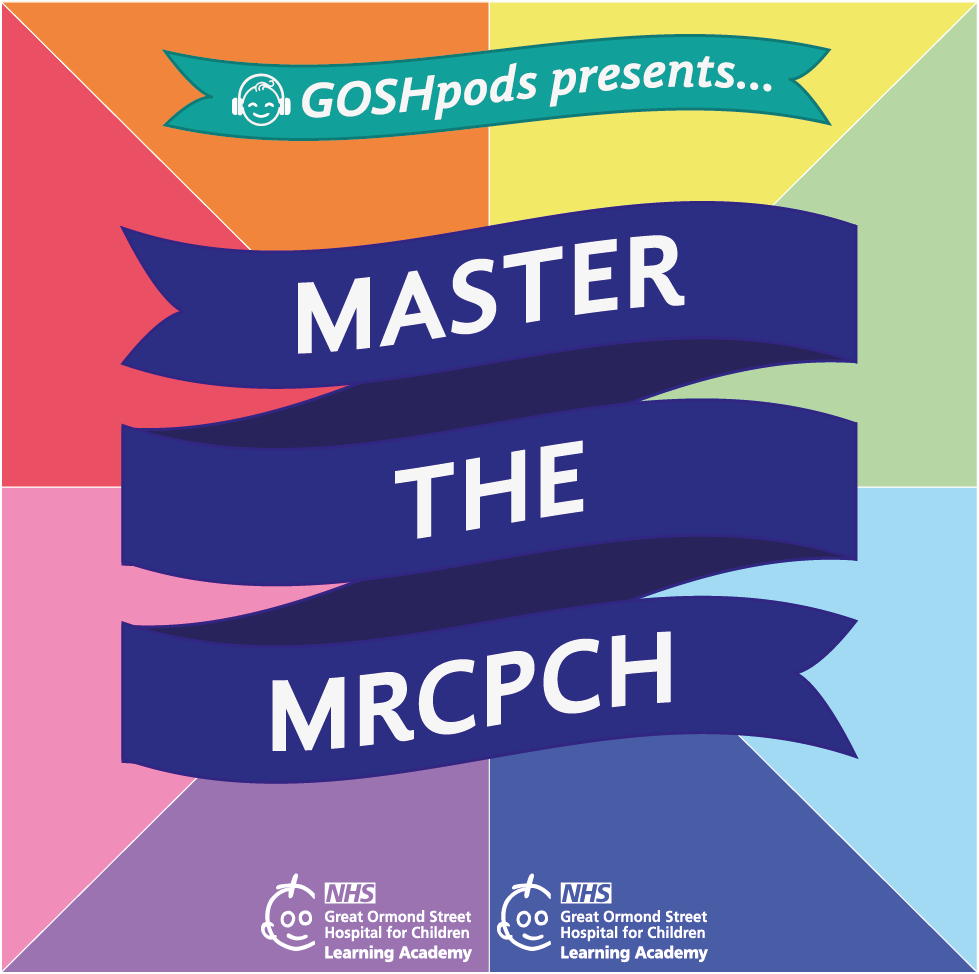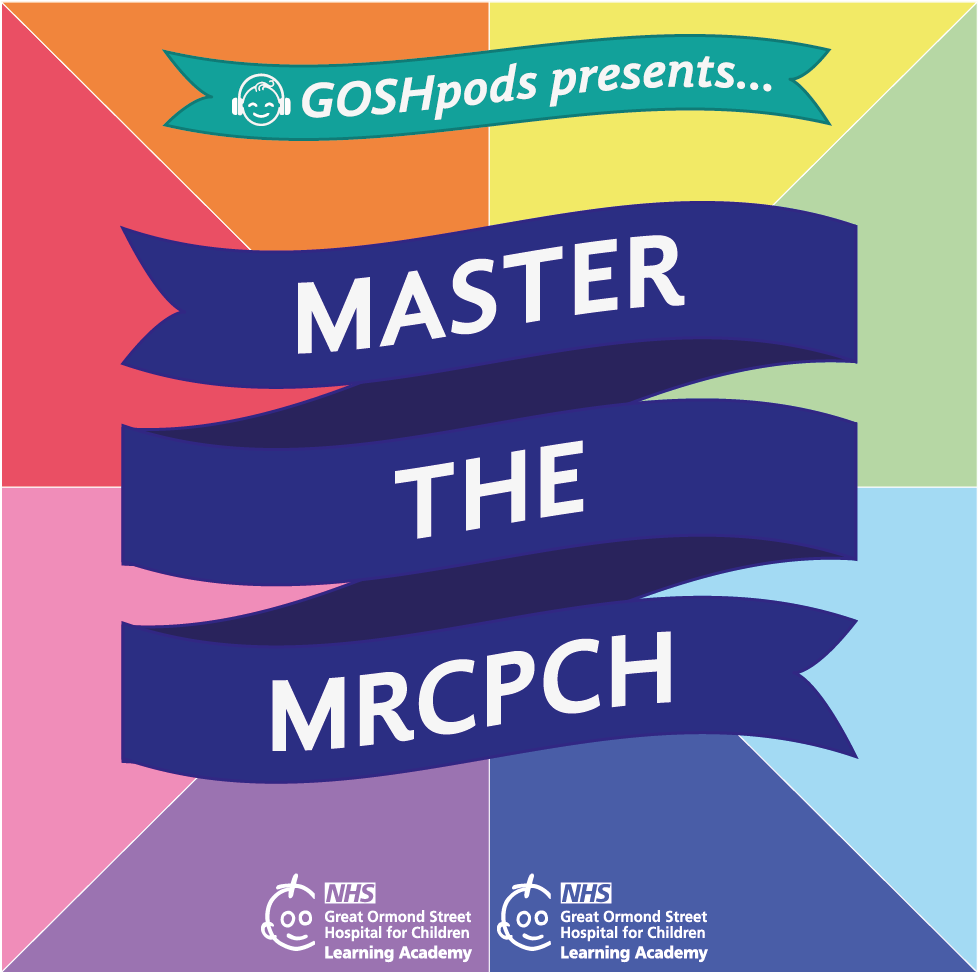This Podcast is brought to you by the GOSH Learning Academy.
SA: Hello and welcome to Master the MRCPCH. In this series, we tap into the expertise here at Great Ormond Street Hospital to give you an overview of a topic on the RCPCH exam curriculum. So whether you're revising for an exam or just brushing up on a need to know topic, hopefully this podcast can give you the information that you need.
I'm Dr. Sarah Ahmed, a paediatric registrar and the current digital learning education fellow here at GOSH.
In today's episode, we will be speaking with Dr. Andy Turnbull, a consultant respiratory paediatrician at Great Ormond Street Hospital. We're going to be discussing asthma, covering aetiology and epidemiology, clinical features, investigation and management. Asthma is definitely a mainstay of the general paediatrician and comes under the respiratory medicine and ENT section of the curriculum.
Andy, thank you very much for joining us today.
Andy: Thank you. Thanks for having me on the program
SA: So let's start with some learning outcomes. What would you like people to get out of listening to this podcast?
AT: I would like to give an overview of asthma for anyone who is preparing for the MRCPCH exam, but also for any paediatric trainee working in a setting in which they will see a child with asthma, and that is, of course, pretty much every paediatric setting.
SA: Yeah, absolutely. Asthma is really very prevalent. Do you have an idea of any of the numbers, the percentages of kids that we see who have asthma?
AT: So, we've got lots of epidemiological data. In the UK, some sort of key figures are that about 1 in 11 children has a diagnosis of asthma or is on asthma treatment, so that's about 9 percent of the paediatric population. And we are probably somewhere in the middle of the range in similar developed countries, so somewhere between 5 and 20 percent would be comparable with other North American, European, Australian countries.
So it's in a highly prevalent condition. It is one of the commonest reasons for presentation to an emergency department or acute asthma attacks are. So it's, it's very common. And it's a cause of significant morbidity and, and unfortunately still a cause of mortality. So we, you know, we have data, I think in 2018, years up to 2018, there were between 15 and 30 asthma deaths in children under the age of 15 each year, and of course, you know, is a tragedy because in, in many cases there are avoidable factors contributing to those deaths. And so we, we knew this from the National Review of Asthma Deaths, a key publication in 2014 that you know, avoidable or modifiable factors are really important in those people who died from asthma. So recognition, under recognition, of asthma severity or lack of appropriate medical reviews, planning of provision of personalized asthma action plans prescription of preventative inhibitors, those types of issues. So it's really important to address aspects of basic asthma care to ensure that we can really do make a dent in those mortality figures.
SA: Yeah, absolutely. The number of kids that die of asthma, it always surprises me that it's as high as it is.
AT: Yeah.
SA: I had a consultant previously, he said it used to be called an asthma attack for a reason, because it is an attack and it does come with significant morbidity and mortality.
AT: That is a really important point and that's really, we should be using that terminology, we have to really, you know, make it understood that asthma carries risk and asthma attacks are risky events that can be life threatening and then sometimes are fatal and we wouldn't, you know, to use the term exacerbation, which is a commonly used term, risks underestimating that severity or, you know, not highlighting that the risks of asthma, which include death.
SA: Can I ask you a really basic and possibly stupid question?
AT: There's no stupid questions, of course.
SA: Do you have a definition for what asthma actually is?
AT: Yes. And and this is important in, how we think about asthma, because it is important that we define the condition. And the most recent GINA definition and the one which is, you know, used globally now is that, we have to think of asthma as a heterogeneous condition. And it is a chronic heterogeneous condition characterized by airway inflammation, usually, and identified by characteristic respiratory symptoms. So, typically, there's a wheeze, chest tightness, dyspnoea, cough, that vary in, over time and in intensity, and are accompanied by variable expiratory airflow limitation. So, you know, reversible airways obstruction on spirometry. So the key points there are there's, there's clinical features that are characteristic of asthma, there's reversible airflow limitation, and there is usually chronic airway inflammation.
SA: So it's a combination of symptoms and also kind of the results you get when you investigate it.
AT: Exactly. And there's a real need to accompany a diagnosis or to achieve, to reach a diagnosis, through both clinical suspicion supported by objective tests, and we'll talk a bit more about that because that is that is important that an asthma diagnosis is made with reliance on objective tests.
SA: We will get onto investigations in a sec, but let's start with the other thing that you mentioned, which is clinical symptoms. So how does asthma generally present in children and is there an age range that is associated with?
AT: Yes, so asthma presents with, you know, across the age range asthma presents with typically those respiratory symptoms. So a child or young person who has episodic respiratory symptoms, usually associated with various triggers, the commonest being viral respiratory infections. And those symptoms are usually a combination of breathlessness, chest tightness, wheeze and, you know, with or without cough. The triggers are important and the variation in those symptoms over time, as we said, that's sort of that whole part of the diagnosis.
So, those are the symptoms that typically present, and they can present in any child across the age span, usually from, you know, the preschool years to a school age child, adolescent and adult. The term asthma is used in the, school age group and upwards, when we support that diagnosis with objective testing, do spirometry. And then we often, you know, term the preschool age group as having preschool wheeze and, and that's important because there is greater heterogeneity in that group. So, preschool is a term that's used as an umbrella term for that group. And you know, some of those children will go on to develop asthma some won't. We can talk more about that.
SA: Well, let's talk about that. Let's talk a little bit about aetiology. What is, what causes asthma?
AT: Ok, it’s a really important point, and it is, it's multifactorial. It's the, it's the simple answer. So it's a sort of, it's an interaction between genetic susceptibility. So, genetic susceptibility, atopy, the impact of respiratory viral infections, particularly in early life, we know that rhinovirus and RSV infections early in life are associated with the development of, asthma. Cause or effect is, is not always certain there. So genetic susceptibility, early life infections, atopy, and then environmental exposures. So, tobacco smoke, air pollution, bacterial environment or presence of bacteria within the environment. And those all interact to impact on asthma aetiology and development.
And this is where the kind of the heterogeneity is so important. Asthma isn't a single disease, we should probably think of it as an umbrella term. It encompasses a kind of group of clinically similar disorders, but there may be distinct pathophysiological processes and perhaps overlapping pathophysiological processes that lead to the sort of clinical syndrome or clinical symptoms of asthma.
So, the objective of kind of asthma care is to understand better the phenotype of individuals with asthma, the sort of either distinct clinical characteristics or physiological or biomarker based characteristics of individuals with asthma to better understand the asthma phenotype and particularly the underlying pathophysiology behind that child's asthma. And we know that predominantly in children, inflammatory phenotype is one of elevated type 2 inflammation. So kind of driven by T helper 2 cells and their associated cytokines that cause exaggerated Th2 inflammatory responses to allergens, viruses other irritants in the airways. And that leads to the process of excess, smooth muscle proliferation, you know, mucus, hyper secretion, airway hyperresponsiveness and airway obstruction. So, that is the, the broadest way of saying that there's a lot of causes that go into asthma genesis. And that the, the way in which those interact is part of why asthma is a heterogeneous disease or a group of diseases.
SA: And then a question that I get a lot, I was going to say from parents, but also from SHOs when I'm working in A& E is – those kids that come in with kind of preschool wheeze, which I think we generally think of as viral induced wheeze.
AT: Yes.
SA: How many of those kids go on to develop asthma? And is it the same condition? Or is it like a spectrum of a condition?
AT: Yeah, it's a really good point. And there's, lots to say about that, and there's lots of research that has been done in that topic, and there's lots of things that are still unknown.
Wheeze in the preschool years is really common. So, you know, by the age of, the data is that by the age of three, one in three children would have had a wheezing episode. By the age of six, that's one in two children. So wheezing in the preschool years is really common, usually with viral infections. And whilst some of those children who wheeze in the preschool years, of course, will go on to develop asthma, the majority don't. So, you know, more than half don't. And we've learned a lot from cohort studies looking at tracking wheeze symptoms or the pattern of symptoms over time with wheezing illnesses. And, you know, we can look at some of the temporal patterns, you know, kind of wheeze that is either transient or persistent or associated with various factors. And those are things that we can apply retrospectively, if we look at children and when they develop wheeze and when they grow out of it. But the question that you ask and what is really important is as the clinician sitting in front of a child who's wheezing, we need to be able to predict or give some indication to the child and the child's family about what the likelihood is of that wheeze persisting.
And so then we have to look at what are the risk factors for persistent wheeze? We know that again, from some of those cohort studies, we know that things that are associated with wheeze persisting are allergic sensitization, positive family history, severity and frequency of wheezing episodes and you know, early life exposures, tobacco smoke and, and air pollution.
And probably the things that are the most important predictors of wheeze progression are both having severe and frequent episodes in the preschool years, so severe and frequent episodes of wheeze, and atopy. Atopy is an allergic error allergen sensitization is a strong predictor of persistent weeds. And in those children, particularly those with severe frequent episodes, you know, there's a, a justification for, treatment and, it's those children whom we want to you know, look at the, options for, maintenance treatment.
SA: So much like asthma itself, it's not a straightforward answer. It's a combination of different things.
AT: Yeah, it's not a straight forward answer and it kind of evolves over time. If we think about even in the last 10 years, for instance, there was efforts to look at preschool wheeze and define it by the pattern of triggers. So if it was, episodic viral wheeze, ie wheeze that occurs, just in association with viruses we would, term it that, viral wheeze. And if it was wheeze that occurred with lots of triggers, we'd term it multi trigger wheeze. And that was in an effort to, it was based on, on a reasonable rationale that there might be different pathophysiological processes going on, and that, there was some evidence that there was greater degrees of airway inflammation in children with multi trigger wheeze than there were in those with episodic viral wheeze, and that therefore you might, you might approach treatment differently. But we then, you know, the sort of subsequent evidence really is that there those, those phenotypes, as we describe them based on triggers, really aren't, stable. Children never just remain in one phenotype and and don't move to the other. There's a lot of movement. Children have episodic viral wheeze for some time and then have when it's triggered by other things and then maybe move back to being triggered only by viruses. And also that the underlying physiology really probably isn't as distinct as we may have thought. So there may be a lot of overlap there and it may not be indicative of separate disease processes. So there's lots of ways in which our understanding has evolved. And then we form hypotheses, further evidence comes to light, we have to revise those. And, and so now probably we've recognized that actually severity, frequency of episodes, is a greater importance to the clinician deciding about which treatment steps to start and perhaps the the pattern of triggers that with which wheeze is associated.
SA: Before we go on to talk about management, can we just talk a little bit about investigation? So if you have a child in front of you and you think they may have asthma based on their clinical symptoms, what are the investigations that you would do to confirm that diagnosis?
AT: This is really important and the, diagnostic pathways for asthma really all there, there are several of them, but the real focus is that confirming a clinically suspected diagnosis of asthma needs to be with objective testing. So, and we come back to that definition at the beginning where asthma is the combination of those characteristic respiratory symptoms with reversible areas obstruction. So the main test to confirm a diagnosis is spirometry and spirometry with bronchodilator reversibility as the main test. So if we see airway obstruction, when somebody does a forced expiratory manoeuvre, and then give them a set dose of short acting bronchodilator, so normally that's four puffs of salbutamol, will then retest it the spirometry, and if there's a greater than 12 percent change in FEV1, then that is a, you know, considered positive of bronchodilator reversibility.
Now, of course, there are so many caveats, because that is the ideal situation. A child with symptoms, you have access to spirometry, you perform the spirometry, the result comes through, and then you can commence treatment.
But very often what's happened is that a diagnosis may have been presumed. Initially, when a child presented in primary care, for instance, and they may not have access to spirometry and the child may have had a successful trial of treatment, or perhaps may not have been adequately reviewed and then they continue on treatment and then symptoms persist or worsen and somebody escalates the treatment and, and the actual original confirmation of the diagnosis with objective testing hasn't ever taken place. So it's really important to, recognize that objective testing does form part of the diagnosis, access to objective testing is really important. And treatment has an impact on some of our objective test results. So, in many cases, once a child is on inhaled corticosteroids, if there is bronchodilator irreversibility, that may be diminished with treatment. So, confirming the diagnosis of asthma sometimes means that it's, it can be, if there's a question mark about the diagnosis, it sometimes means a reduction in inhaled steroid dosing in a controlled fashion can be, can be useful to, perform diagnostic testing.
And then in addition to spirometry, some of the guidelines, particularly in the BTS and SIGN guidelines for asthma and the ERS, the European Respiratory Society guidelines focus on the value of FENO, which is an invasive marker, the fraction of exhaled nitric oxide, as a basic biomarker of eosinophilic airway inflammation. And an elevated FENO value is associated with asthma and in some cases where spirometry is normal then certain guidelines recommend that elevated FENO, with an appropriate clinical history can be supportive of a diagnosis of asthma.
So that's a useful test but really spirometry with reversible areas obstruction is the best test.
SA: Can we talk a little bit about managing asthma?
AT: Yes, of course. So really, asthma management has a number of pillars. Firstly, patients with a diagnosis of asthma should be supported to understand their asthma and really know what to do in the event of them developing worsening symptoms. So a real cornerstone of asthma care is supported self-management. So providing patients and their families with asthma action plans so that they knew what to do in a situation where that asthma control is deteriorating. Making sure they know, you know, which medicines? Are there controller medicines that they have to take regularly? Are there reliever therapies that they have to take in response to worsening symptoms? What level of symptoms or peak flow or escalation of treatment requires an escalation of care. So who they should contact a GP or attending hospital locally or calling an ambulance. And really making sure that patients and families are empowered to, undertake self management early on in any worsening of symptoms.
As doctors in the acute setting, of course, parents will bring their children to A& E when usually they've been having symptoms that haven't responded to the first line therapies, so salbutamol given at home through a air pressurized metered dose inhaler with a spacer. And they will come to hospital, and then the important job as the physician seeing that child is to take a focus history, recognize that this is an asthma attack. You know, think about the other differentials that it could be in the acute setting, inhaled foreign body or you know, pneumonia other, you know, acute upper respiratory infection, variety of things, but make sure you're taking a, focussed history. Identify, to some degree any underlying risks. So, you know, is this child known to have asthma? Have they had severe attacks in the past? Have they ever been to intensive care? What treatments are they on? So it's important to understand asthma and asthma risk and then do a focused examination, you know, again, a respiratory examination to determine asthma severity and look at asthma severity in line with how we think about it in the kind of APLS algorithms and BTS SIGN guidelines. So that's really making sure that we're recognizing a child who has, might have life threatening asthma, who appears exhausted and hypoxemic and who may not actually have increased work of breathing because they're totally exhausted. And if they've got blood gas derangement, really highlighting you, you know, need to be aware of severity and make that assessment quite quick and call for help in a child with severe or life threatening asthma early.
Then treatment is also, you know, it's fairly guideline based. So, I think most trainees, you know, within the UK and elsewhere will need to, to be familiar with their local guidelines and, you know, kind of international guidelines like GINA. APLS talks about this very well. But the kind of standardized treatments, treatments for asthma are based on severity, but include inhale bronchodilators either with a spacer if the child doesn't need enough supplemental oxygen, or through a nebulizer if the child does. Oxygen to keep, you know, if the saturations are less than 94%, giving supplemental oxygen to maintain them above that. Systemic steroids, usually given orally, given intravenously if the child can't tolerate oral medicines.
And those are the first line treatments. And then most children, of course, respond to first line treatments, and then those that do not need second line treatments, which would include IV magnesium sulphate, IV salbutamol, IV aminophiline, and again, local guidelines might vary in terms of which order of things are used, and early escalation of care.
The important thing in the management of any child with acute asthma is early treatment, regular reassessment, and awareness of potential deterioration and the need for escalation of therapy. And if all that is done appropriately, the outcomes for, acute asthma in hospital are relatively good. You know, most, most children get better respond to first line treatments. Those that don't mostly do respond to second line treatments. Actually, some of the bigger areas where there can be real problems are in asthma presenting in the community where severity is unrecognized and children present late. So, so really following our guideline based care is, really important in hospital.
SA: And then thinking about more long term treatment, what kind of medications do you utilize in that?
AT: Yeah. So again, this is really well set out in a number of guidelines. I really highlight the 2023 update of the GINA guidelines as being the most appropriate resource here. And again, you know, there's a sort of the long term management of asthma is based on the level of symptoms, the level of risk, and regular reassessment of that, and then tailoring treatment specific to the individual child to make sure that a child is on the right amount of treatment to control symptoms, reduce risk of attacks, but not on excessive treatment beyond what they need. And there are step one to five ladders of treatment that really begin with low dose inhale corticosteroids and move up to additional therapies.
I think the most important change has been in the last few years in how we treat asthma at step one. It used to be the case that it was recommended that children have short acting beta agonists if they had infrequent symptoms and that would be the first line of therapy. We really recognize that children with mild asthma are still at risk of adverse outcomes and you know, treatment with inhaled corticosteroids even in mild asthma is justified because that can modify risk and short acting beta 2 agonists, over reliance particularly is associated with adverse outcomes.
So it's really important that children are on inhaled corticosteroids as their early, as the step one treatment. And for children between six and 12, that would be inhaled corticosteroids any time short acting beta 2 agonists are used. And for children over 12, that would be a combination inhaler of an inhaled corticosteroid with a long acting beta 2 agonist that is also fast acting. So that's called anti inflammatory reliever therapy, this overall strategy. So the importance is that at step one, children are getting anti inflammatory therapy, inhaled corticosteroids, in addition to bronchodilator therapy. And then steps 2, 3, 4 really are an escalation of both, you know, regular inhaled corticosteroids at low and then moderate dose with addition of added controllers. So leukotriene receptor antagonists or increasing inhaled steroid dose or addition of the long acting beta 2 agonist if it's not already added earlier steps. So those, those treatment steps can be found in GINA, as well as BTS SIGN, or other asthma guidelines. And it's important that at each step of treatment, we review response, and we review those basics, you know, particularly around, do parents and children understand what treatment they're on and how to take their inhalers.
SA: And then to Spacer or not to Spacer?
AT: Always to spacer. So, well, sorry, always to use a spacer with pressurized meter dose inhalers. Of course, there's a lot of dry powder inhalers and they don't need a spacer.
SA: So how is your patient population different than the population of kids that you would see in a DGH?
AT: Yeah that's an important question. So, many children with asthma have their asthma managed appropriately in primary and secondary care and have their symptoms controlled and their asthma appropriately managed with low dose inhaled corticosteroids. That's the majority of children with asthma. The treatment ladders focus on targeting treatment to the appropriate level for the patient's symptoms and risk and therefore escalating inhaled therapies and adding on therapies, or reducing those according to, symptom control and asthma control. Where children have poor asthma control or ongoing asthma attacks despite medium dose treatment and despite the effectively level four treatment GINA based treatment, so at least moderate inhaled steroids plus a second controller. Where they have poor asthma control or ongoing attacks, despite that treatment, then they can be termed as having severe asthma and or problematic severe asthma as a kind of overarching term for people whose asthma is not effectively managed with standard treatments or standard treatments at standard doses.
And they're a group who really warrant attention in lots of domains. Particularly, first of all, you know, is the diagnosis of asthma correct? Is it asthma that this child has? Or is there an important differential diagnosis that has been overlooked or is contributing to symptoms in addition to asthma?
Is, are the basics of asthma control being done correctly? You know, is the child being prescribed the appropriate medication through an appropriate device that they can use, that the family understand, that they can access, and that is being used consistently as it's prescribed? And are there any important continuing exposures, you know, that are making that child's asthma worse? Are they living in a family where the parents smoke? Are there pets to which they are sensitized sharing the room with the child? Are there ongoing adverse psychosocial issues? Is there, is there damp and mould in the home? Are there, exacerbating factors effectively?
And yeah, then, if you can address all of those basics of asthma management then in some cases, children need escalation of care, but actually the majority of the time, there's something about asthma basics and understanding the diagnosis, understanding comorbidities that can usually mean children's asthma can be improved by addressing those aspects of care. Poor adherence is a really common reason for asthma control being poor. And it's difficult to sometimes determine that.
And then there are a small group of children with severe asthma who actually do have true severe disease, therapy resistant asthma. And in those children and young people, we often have to think about escalating treatments, changing some aspects of the basic asthma treatments, but also consideration of biologics, which are the, the next add on level of asthma treatment for a small subgroup of patients.
SA: And I'm guessing if you have well controlled asthma, then the prognosis is pretty good?
AT: Yes. So again, from kind of longitudinal studies, we know that some children's asthma can diminish and can disappear as they grow older, but not all. And it's variable. It's, you know, depends again on some of those risk factors we discussed at the beginning of the episode. And we know that people's lung function and lung function trajectory can be set in childhood and can track into and does track into adulthood. So we know that children who have, you know, particularly severe asthma in childhood with frequent or severe attacks, and who have a lung function deficit in early childhood, that deficit will track. So our lung function peaks usually in our early twenties and then diminishes thereafter. And those who have an early deficit and reach a lower peak than we predicted will have a lower lung function in decades to come. And, and so there are risks, you know, of particularly those who have low lung function, there are risks of, you know, ongoing severe exacerbations and, and early loss of lung function.
SA: I wanted to end with some quickfire questions. So are there any classic exam questions that can pop up about asthma?
AT: A sort of frequent one that might pop up is you know, talk through an asthma action plan, review inhaler technique with a child and parent. And so you mentioned spacers that's really important. So you can always think about spaces and somebody using a metered or dose inhaler and know about dry powder in here. I don't think it would be expected that everyone needs to. You know, know in their head how to use every inhaler, but it would be important to be able to know what resources to look at and nice publish guidance on different inhaler types. There's an app called Right Breathe. That's very useful. Often will suggest to parents that they look at that for a particular inhaler to remind them there's some useful videos that go through with parents. It might be asked in an exam question to discuss smoking cessation and adverse exposures with a family whose child has asthma, because it's really important that we, do address that in our clinical encounters, that we recognize passive smoking as a risk and address that where possible, and avoidance of triggers in general.
And you might be asked to examine a child with asthma, but of course, in many cases, a child who has asthma, who is in the outpatient setting or in an MRCPCH examination room might have no findings on examination, but it would be useful to then think about what tests you'd want to do and asthma control test questionnaires with the patient would be important. Checking spirometry, looking for reversible area subtraction, measuring FENO, doing a peak flow. Those are some of the tests that we can use to gain objective assessments in an asthma review.
SA: Absolutely. And you've already mentioned a couple of these, but are there any useful resources that you'd recommend? And I'll make sure everything is linked in the description.
AT: Okay, people should be familiar with GINA. BTS and SINE and NICE are also relevant guidelines for people based in the UK. Asthma and Lung UK is a very useful website for information for parents particularly and has asthma action plans that can be used. And an important resource to be aware of in the UK again is the National Asthma Bundle which looks at a whole systems approach to asthma care from diagnosis, adverse exposures through to severe asthma. It's a really important resource for people in the UK to be aware of.
SA: Fantastic. And finally, what are your three takeaway learning points?
AT: So three important learning points I would say are really recognize the need for making an objective, for using objective tests to support an asthma diagnosis. There'll be many children out there with a label of asthma who need that to be either confirmed or, or in fact, you know, excluded but objective testing is the way to do that.
Get the basics right. Always readdress those. It's always important to revisit you know, inhaler management, inhaler technique, adherence, exposures, all of those things. We just do that at every clinic encounter and it's so important because often that's where gaps in those areas often are associated with poor asthma control.
And be aware of asthma severity. It's important that everyone is aware that asthma is a disease that can kill, and that we have to take very seriously. Even in people with supposedly mild asthma, there is risk, and that's why it's important that, that we get those basics right, that we support self management, that we address aspects of asthma care, throughout patients time under our care.
SA: Amazing. Andy, thank you so much for a really comprehensive and useful overview of a very common topic in paediatrics.
AT: No problem. My pleasure to be on. Thank you for the invitation.
SA: Thank you for listening to this episode of Master the MRCPCH. We would love to get your feedback on the podcast and any ideas you may have for future episodes. You can find link to the feedback page in the episode description, or email us at digital
[email protected]. If you want to find out more about the work of the GOSH Learning Academy, you can find us on social media, on Twitter, Instagram, and LinkedIn.
You can also visit our
[email protected] and Search Learning Academy. We have lots of exciting new podcasts coming soon. So make sure you're subscribed wherever you get your podcasts. We hope you enjoy this episode and we'll see you next time. Goodbye.

